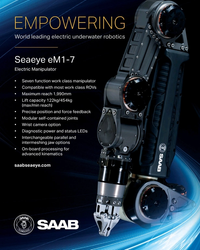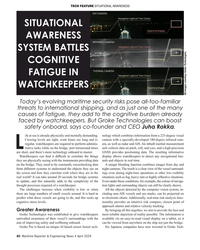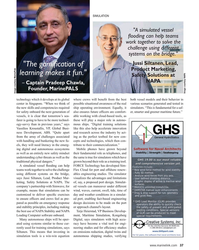S Task Force On Ports
-
- What a Difference a Year Makes Marine News, Mar 2013 #32
Channel and water management will become increasingly important for freshwater supplies and trade in the years to come. The work and our vigilance must continue.
The present conditions on the Lower Mississippi River find the deep-draft channel from Baton Rouge to the Gulf of Mexico in good shape with no channel deficiencies or related transit restrictions. On the other hand, the Middle Mississippi from St. Louis to Cairo and especially around the areas with rock pinnacles at Thebes and Grand Tower both in Illinois have been areas of concern for much of the last two months. The Commander of the USACE Mississippi Valley Division Brigadier General John Peabody now believes that due to several factors, including the work to remove the problematic pinnacles, new precipitation and managed releases from the Carlyle and Shelbyville Reservoirs have all helped to maintain – at least for now – the authorized channel depth.
The federally authorized channel for most of the entire river system is 9 x 300 ft. although outside times of extreme drought barge traffic often is able to load deeper than the authorized depth because of water availability. Nevertheless, industry members remain concerned about water levels and have responded to concerns by enforcing their own draft reductions to promote safety. As one variable of the equation only, the possibility of long term drought and the disruption to the maritime transportation system is one that only Mother Nature can solve.
The startling differences in water levels over the course of just one year (from 2011 to 2012), record, historic highs as it turned out, show that as man tries to manage this immense watershed that natural processes are in fact in control. I have two photos that show the difference in water level between these two historical events and it is amazing what a difference 60 feet of water looks like. In 2011 with the Carrolton Gauge in New Orleans at 17 ft. and predicted to reach 18.5 ft., I found myself contemplating evacuation from New Orleans much like we would do if a significant hurricane were approaching. Hurricane Isaac showed that a Category 1 on the Safford-Simpson scale could really be a devastating storm, just as the National Weather Service often tells us. Every storm brings threats that must be prepared for. For example, and during the historic floods of 2011, before the Carrollton Gauge got much higher than 17 feet, the USACE opened the Bonnet Carre and Morganza Spillways to manage the record water levels with controlled releases.
After the preparations and the storms pass, restoration projects begin. Beach restoration projects are often questioned on the justification for the financial support from state or federal funds. There is considerable evidence that beach locations that had been maintained or restored offered tremendous protection to their local communities. In the wake of the impact of recent hurricanes – like Katrina, for example – a select few members from the navigation industry have worked to increase the beneficial use of dredge material. Historically, this material had been referred to as dredges spoils and I think that is simply an inappropriate term with negative connotations for material that could be used to help restore coastal Louisiana. A better descriptive term perhaps is “marsh recycling.”
The Big River Coalition has worked to develop plans to promote the marsh recycling program and hopes to be able to test one portion of this plan through hopper dredge pumpout in Southwest Pass this year. It is therefore important that the navigation industry work to promote coastal restoration. Unfortunately, because of the Corps being severely underfunded, these plans have been impossible to implement financially. And this reality underscores the need to repair the Harbor Maintenance Trust Fund mechanism.
There are several recent studies that suggest one out of five jobs in Louisiana depends on the Mississippi River. Members of the navigation industry also want coastal restoration for a myriad of reasons including protecting their families and homes, human lives, our unique culture shaped by the gumbo of our waterways and yes, the facilities which our part of our economic lives. Navigation interests want the sediments out of the channel to maintain authorized safe dimensions and what better place for this material to be placed than along our coastal boundaries.
Challenges beyond trying to manage the Mighty Mississippi and the super environmental impacts include preparing for the Panama Canal expansion that will have an undeniable impact on our industry and nation. Many channels are presently undergoing efforts to be deepened to 50 feet. The President’s Task Force on Ports has announced plans to expedite several port deepening projects and I cannot think of a more important channel than the world’s economic superhighway (Mississippi River).
The Mississippi River channel was approved for deepening to 55 feet in 1986, but at in the same Water Resources Development Act (WRDA Bill) another section established that all channels deeper than 45 feet would be deepened and maintained with 50% funding from the federal government and 50% from the non-federal sponsor. Because of this overwhelming requirement, the channel was never deepened. In the last year the Big River Coalition has begun working on a compromise to see the channel deepened to 50 feet, a compromise that we hope will allow the channel to be maintained at 50 feet and to develop marsh recycling to help protect our coast. At the same time, advocacy efforts continue from BRC to educate Congress and the administration on the importance on this trade artery and the positive impact on the 31 states it connects to world markets through the Mississippi River Basin.
There is no doubt that in the next few decades the channel and water management will become increasingly important for freshwater supplies and trade. As an example, world governments could work to make desalinization affordable and promote this technology. As sea levels rise and glaciers melt, you can argue about the causes, but the future of a civilization that could economically and efficiently convert sea water to fresh water would arguably establish its future in the ever-changing world in which we live. This is of course a long-term goal while deepening the Mississippi River to 50 feet could be done in months.
In some quarters, realignment of the Mississippi River channel or delta so that the riverine system would be more naturally able to promote marsh restoration has been proposed. Whether this is a practical matter is far from certain, but it will remain important that navigation interests are embedded with these teams if the concept is brought forward. Changes to this channel have unintended consequences and the threat to the nation’s economy makes this effort one that warrants extreme scrutiny to protect the $120 billion annual impact generated by this channel. Losing the Mississippi River for ship traffic would be a blow to the U.S. economy that it may never recover from and it is important to remember that waterborne commerce is the cheapest, safest and most environmentally friendly mode of transportation.
(As published in the March 2013 edition of Marine News - www.marinelink.com)
-
 )
March 2024 - Marine Technology Reporter page: 45
)
March 2024 - Marine Technology Reporter page: 45ronments. The new agreement will address speci? c techni- cal gaps in the UUV defense and offshore energy markets especially for long duration, multi-payload mission opera- tions where communications are often denied or restricted. As part of the new alliance, Metron’s Resilient Mission Autonomy portfolio
-
 )
March 2024 - Marine Technology Reporter page: 44
)
March 2024 - Marine Technology Reporter page: 44NEW TECH OCEANOLOGY INTERNATIONAL 2024 Image courtesy Metron/Cellula Teledyne Marine acquires Valeport: Matt Quartley, MD, Valeport and Ole Søe-Pedersen, VP & Image courtesy Teledyne Marine GM Teledyne Marine announce the deal in London. Pictured (L-R): Cellula Robotics, President, Eric Jackson, Metron
-
 )
March 2024 - Marine Technology Reporter page: 36
)
March 2024 - Marine Technology Reporter page: 36LANDER LAB #10 Of special interest for marine applications, LiPo batteries are Shipping any kind of lithium battery can be a challenge, and offered in a “pouch” design, with a soft, ? at body. The pouch IATA regs vary with the batteries inside or outside an instru- is vacuum-sealed, with all voids ?
-
 )
March 2024 - Marine Technology Reporter page: 35
)
March 2024 - Marine Technology Reporter page: 35Figure 1 A self-righting vehicle design with buoyancy high and weight low, WHOI’s SeaBED AUV captures the attention of a pair of curious Antarctic penguins as it is deployed from the British research vessel James Clark Ross. Vehicle designers allowed for temperature reduction of battery capacity. Recharge
-
 )
March 2024 - Marine Technology Reporter page: 23
)
March 2024 - Marine Technology Reporter page: 23elatively inactive since 2014, the Hunga Tonga–Hunga Ha‘apai (HT-HH) submarine volcano began erupting on December 20, 2021, reaching peak intensity on January 15, 2022. This triggered tsunamis throughout the Pa- R ci? c, destroyed lives and infrastructure, and generated the largest explosion recorded
-
 )
March 2024 - Marine Technology Reporter page: 19
)
March 2024 - Marine Technology Reporter page: 19About the Author vey with the pipe tracker is not required, resulting in signi? - Svenn Magen Wigen is a Cathodic Protection and corrosion control cant cost savings, mainly related to vessel charter. expert having worked across The major advantage of using FiGS on any type of subsea engineering, design
-
 )
March 2024 - Marine Technology Reporter page: 18
)
March 2024 - Marine Technology Reporter page: 18TECH FEATURE IMR There are also weaknesses in terms of accuracy because of FiGS Operations and Bene? ts signal noise and the ability to detect small ? eld gradients. In Conventional approaches to evaluating cathodic protection this process there is a risk that possible issues like coating (CP)
-
 )
March 2024 - Marine Technology Reporter page: 16
)
March 2024 - Marine Technology Reporter page: 16TECH FEATURE IMR Image courtesy FORCE Technology OPTIMIZING CATHODIC PROTECTION SURVEY USING NON-CONTACT SENSORS By Svenn Magen Wigen, FORCE Technology he principle behind sacri? cial anodes, which are water structures, reducing the need for frequent repairs and used to safeguard underwater pipelines
-
 )
March 2024 - Marine Technology Reporter page: 11
)
March 2024 - Marine Technology Reporter page: 11assist in identifying mines and act as a neutralization device. About the Author Bottom mines pose even greater chal- David R. Strachan is a defense analyst and founder of lenges. Unlike contact mines, bottom Strikepod Systems, a research and strategic advisory mines utilize a range of sensors to
-
 )
March 2024 - Marine Technology Reporter page: 8
)
March 2024 - Marine Technology Reporter page: 8INSIGHTS SUBSEA DEFENSE Copyright RomanenkoAlexey/AdobeStock WHEN THE SHOOTING STOPS: BLACK SEA MINE CLEARANCE WILL FEATURE ADVANCED TECH, CONOPS By David Strachan, Senior Analyst, Strikepod Systems ince the beginning of the war in Ukraine, mine warfare mines have been the weapon of choice for both
-
 )
March 2024 - Marine Technology Reporter page: 4
)
March 2024 - Marine Technology Reporter page: 4Editorial NIWA-Nippon Foundation TESMaP/ Rebekah Parsons-King www.marinetechnologynews.com ast month marked the resounding NEW YORK 118 E. 25th St., New York, NY 10010 return of Oceanology Interna- Tel: (212) 477-6700; Fax: (212) 254-6271 tional in London, perennially one Lof the world’s most important
-
 )
March 2024 - Marine Technology Reporter page: 3
)
March 2024 - Marine Technology Reporter page: 3EMPOWERING World leading electric underwater robotics Seaeye eM1-7 Electric Manipulator • Seven function work class manipulator • Compatible with most work class ROVs • Maximum reach 1,990mm • Lift capacity 122kg/454kg (max/min reach) • Precise position and force feedback • Modular self-contained
-
 )
April 2024 - Maritime Reporter and Engineering News page: 43
)
April 2024 - Maritime Reporter and Engineering News page: 43“The industry is an ecosystem which includes owners, managers, mariners, shipyards, equipment makers, designers, research institutes and class societies: all of them are crucial,” – Eero Lehtovaara, Head of Regulatory & Public Affairs, ABB Marine & Ports All images courtesy ABB Marine and Ports provi
-
 )
April 2024 - Maritime Reporter and Engineering News page: 42
)
April 2024 - Maritime Reporter and Engineering News page: 42OPINION: The Final Word Seeing the Ship as a System Shipping must engage with the decarbonization realities that lie ahead by changing the way it crafts maritime legislation to re? ect its place in the interconnected, interdependent world economy, said Eero Lehtovaara, ABB Marine & Ports. ABB Marine &
-
 )
April 2024 - Maritime Reporter and Engineering News page: 41
)
April 2024 - Maritime Reporter and Engineering News page: 41Nautel provides innovative, industry-leading solutions speci? cally designed for use in harsh maritime environments: • GMDSS/NAVTEX/NAVDAT coastal surveillance and transmission systems • Offshore NDB non-directional radio beacon systems for oil platform, support vessel & wind farm applications
-
 )
April 2024 - Maritime Reporter and Engineering News page: 40
)
April 2024 - Maritime Reporter and Engineering News page: 40TECH FEATURE SITUATIONAL AWARENESS SITUATIONAL AWARENESS SYSTEM BATTLES COGNITIVE FATIGUE IN WATCHKEEPERS All images courtesy Groke Technologies Today’s evolving maritime security risks pose all-too-familiar threats to international shipping, and as just one of the many causes of fatigue, they add
-
 )
April 2024 - Maritime Reporter and Engineering News page: 38
)
April 2024 - Maritime Reporter and Engineering News page: 38Tech Files Latest Products, Systems and Ship Designs Zero-Emission Mooring Service of a Tanker Consulmar achieved a milestone by executing what it calls ing boat Castalia, which operates on full electric propulsion. the world's ? rst zero-emissions mooring service for a tanker. Equipped with two 150 kW
-
 )
April 2024 - Maritime Reporter and Engineering News page: 37
)
April 2024 - Maritime Reporter and Engineering News page: 37SIMULATION "A simulated vessel ? ooding can help teams work together to solve the challenge using different systems on the bridge." – Jussi Siltanen, Lead, "The gami? cation of Product Marketing, learning makes it fun." Safety Solutions at NAPA – Captain Pradeep Chawla, Founder, MarinePALS Image
-
 )
April 2024 - Maritime Reporter and Engineering News page: 35
)
April 2024 - Maritime Reporter and Engineering News page: 35SIMULATION e have a close relationship with tech- Realism is prized beyond immersive, photo-realistic visu- nology, evidenced by, for example, als, and providers are introducing increasingly accurate func- the phones we are estimated to un- tionality. FORCE Technology’s upcoming DEN-Mark2 math- lock around
-
 )
April 2024 - Maritime Reporter and Engineering News page: 32
)
April 2024 - Maritime Reporter and Engineering News page: 32FEATURE A closeup of a blade installation process taken via drone. A blade handling system is apparent (in yellow). Images courtesy of Mammoet requirement for the development of these cranes, particularly ling area. This would result in a major time and fuel saving. in ? oating offshore wind,” says
-
 )
April 2024 - Maritime Reporter and Engineering News page: 28
)
April 2024 - Maritime Reporter and Engineering News page: 28FEATURE INTERVIEW track missiles and warheads for the Mis- sile Defense Agency, and it travels with its support ship, the MV Hercules. For our Service Support ships, we have the two hospital ships, USNS Mer- cy and Comfort; two rescue and salvage ships; two submarine tenders; and the Sixth Fleet ?
-
 )
April 2024 - Maritime Reporter and Engineering News page: 27
)
April 2024 - Maritime Reporter and Engineering News page: 27RADM PHILIP SOBECK, MILITARY SEALIFT COMMAND With COVID, we had to make some hard choices for our Do your CIVMARs have upward mobility? mariners because we couldn’t rotate. Many of our mariners The Navy has Sailors who become “Mustangs,” and work found other employment, and were able to use their skills
-
 )
April 2024 - Maritime Reporter and Engineering News page: 25
)
April 2024 - Maritime Reporter and Engineering News page: 25RADM PHILIP SOBECK, MILITARY SEALIFT COMMAND Photo by Brian Suriani USN Military Sealift Command From a global supply chain perspective, What makes MSC so vital to the we’ve learned a lot about dealing with Navy’s ? eet and our military disruptions. COVID delivered a big forces around the world? wake-up
-
 )
April 2024 - Maritime Reporter and Engineering News page: 21
)
April 2024 - Maritime Reporter and Engineering News page: 21ROB LANGFORD, VP, GLOBAL OFFSHORE WIND ob Langford has worked in the offshore industry ABS. “We are growing and evolving our services across all for more than three decades, ‘cutting his teeth’ offshore infrastructure along with our continued support to the in a UK design ? rm working in the North Sea
